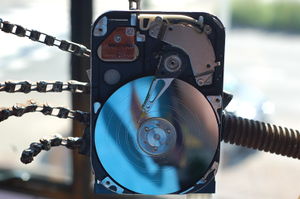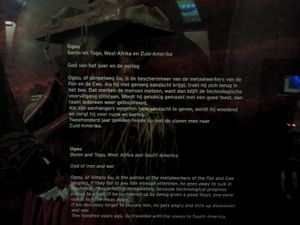Difference between revisions of "God of Technology"
| Line 10: | Line 10: | ||
[[Image:Ogou.jpg|300px]] [[Image:OgouSign.jpg| 300px]] | [[Image:Ogou.jpg|300px]] [[Image:OgouSign.jpg| 300px]] | ||
| − | It is a sculpture of the [http://en.wikipedia.org/wiki/Yoruba_religion Yoruba] "god"<ref>He is not really a god, but rather an orisha and loa. [http://en.wikipedia.org/wiki/Ogoun Orisha] is a spirit or deity that reflects one of the manifestations of Olodumare (God) in the Yoruba. Orisha is an "intermediary between man and the supernatural. The [http://en.wikipedia.org/wiki/Loa Loa], likewise are see to bee the spirits of Haitian Vodou. They are also referred to as Mystères and the Invisibles, in which are intermediaries between Bondye (Bon Dieu, or good god)—the Creator, who is distant from the world—and humanity. Unlike saints or angels however, they are not simply prayed to, they are served. They are each distinct beings with their own personal likes and dislikes, distinct sacred rhythms, songs, dances, ritual symbols, and special modes of service. Contrary to popular belief, the loa are not deities in and of themselves; they are intermediaries for a distant Bondye. The term is often translated as "deities" or "divinities" </ref> [http://en.wikipedia.org/wiki/Ogoun Ougun] who presides over iron, hunting, politics and war. | + | It is a sculpture of the [http://en.wikipedia.org/wiki/Yoruba_religion Yoruba] "god" |
| + | <ref>He is not really a god, but rather an orisha and loa. [http://en.wikipedia.org/wiki/Ogoun Orisha] is a spirit or deity that reflects one of the manifestations of Olodumare (God) in the Yoruba. Orisha is an "intermediary between man and the supernatural. The [http://en.wikipedia.org/wiki/Loa Loa], likewise are see to bee the spirits of Haitian Vodou. They are also referred to as Mystères and the Invisibles, in which are intermediaries between Bondye (Bon Dieu, or good god)—the Creator, who is distant from the world—and humanity. Unlike saints or angels however, they are not simply prayed to, they are served. They are each distinct beings with their own personal likes and dislikes, distinct sacred rhythms, songs, dances, ritual symbols, and special modes of service. Contrary to popular belief, the loa are not deities in and of themselves; they are intermediaries for a distant Bondye. The term is often translated as "deities" or "divinities" </ref> | ||
| + | |||
| + | [http://en.wikipedia.org/wiki/Ogoun Ougun] who presides over iron, hunting, politics and war. | ||
The sign says: Ogou, (Benin and Togo, West Africa and SOuth America. ''God of iron and war'' Ogou, or simply Gu, is the patron of the metalworkers of the Fon and Ewe peoples. If they fail to pay him enough attention, he goes away and sulks in the forest. People notice immediately, because technological progress comes to a halt. If he is cheered up by being given a good feast, everyone start to have ideas again. If his devotees forget to placate him, he gets angry and stirs up dissension and war. Two hundred years ago, Gu traveled with the slaves to South America. | The sign says: Ogou, (Benin and Togo, West Africa and SOuth America. ''God of iron and war'' Ogou, or simply Gu, is the patron of the metalworkers of the Fon and Ewe peoples. If they fail to pay him enough attention, he goes away and sulks in the forest. People notice immediately, because technological progress comes to a halt. If he is cheered up by being given a good feast, everyone start to have ideas again. If his devotees forget to placate him, he gets angry and stirs up dissension and war. Two hundred years ago, Gu traveled with the slaves to South America. | ||
| Line 55: | Line 58: | ||
Image:Robot1.jpg | Strill just break-pads and junk steel... | Image:Robot1.jpg | Strill just break-pads and junk steel... | ||
<gallery> | <gallery> | ||
| + | |||
| + | {{Reflist}} | ||
Revision as of 19:46, 4 June 2012
| Project God of Technology | |
|---|---|
| Status | In progress |
| Contact | User:Gori |
| Last Update | 2012-06-04 |
I was inspired to build a sculpture based on this sculpture I saw in Museon in The Hague.
It is a sculpture of the Yoruba "god" <ref>He is not really a god, but rather an orisha and loa. Orisha is a spirit or deity that reflects one of the manifestations of Olodumare (God) in the Yoruba. Orisha is an "intermediary between man and the supernatural. The Loa, likewise are see to bee the spirits of Haitian Vodou. They are also referred to as Mystères and the Invisibles, in which are intermediaries between Bondye (Bon Dieu, or good god)—the Creator, who is distant from the world—and humanity. Unlike saints or angels however, they are not simply prayed to, they are served. They are each distinct beings with their own personal likes and dislikes, distinct sacred rhythms, songs, dances, ritual symbols, and special modes of service. Contrary to popular belief, the loa are not deities in and of themselves; they are intermediaries for a distant Bondye. The term is often translated as "deities" or "divinities" </ref>
Ougun who presides over iron, hunting, politics and war.
The sign says: Ogou, (Benin and Togo, West Africa and SOuth America. God of iron and war Ogou, or simply Gu, is the patron of the metalworkers of the Fon and Ewe peoples. If they fail to pay him enough attention, he goes away and sulks in the forest. People notice immediately, because technological progress comes to a halt. If he is cheered up by being given a good feast, everyone start to have ideas again. If his devotees forget to placate him, he gets angry and stirs up dissension and war. Two hundred years ago, Gu traveled with the slaves to South America.
As an engineer and hacker I could instantly relate to the notion. Especially the part where the honoration of the good keeps him happy and technology progresses ( see sign). To give you a sense of just how bad-ass Ogoun is, please consider the description of an Ogou ritual :
" His possessions can sometimes be violent. Those mounted by him are known to wash their hands in flaming rum without suffering from it later. They dress up in green and black, wave a sabre or machete, chew a cigar and demand rum in an old phrase "Gren mwe fret" (my testicles are cold). Often, this rum is first poured on the ground, then lit and, finally, the fumes generated by this are then allowed to pervade the peristyle. The sword, or much more commonly the machete, is his weapon and he often does strange feats of poking himself with it, or even sticking the handle in the ground, then mounting the blade without piercing his skin."
The collaborative creation process has lead to a case of extreme casemodig. This sculpture (refered to by Revspacers as the "robot") is a fully functional PC, with a debian 6 install. Many people contributed physical labor and ideas to the sculpture. Thanks! You too are welcome to physicaly/software hack it.
It is build entirely from waste parts.
PC details
- Username: root/gori
- Password: geheim
Specs: <soon>
<gallery>
Image:Robot26.JPG
Image:Robot25.JPG
Image:Robot24.JPG
Image:Robot23.JPG
Image:Robot22.JPG
Image:Robot21.JPG
Image:Robot19.jpg
Image:Robot17.jpg
Image:Robot18.jpg
Image:Robot16.jpg
Image:Robot15.jpg
Image:Robot14.jpg
Image:Robot13.jpg
Image:Robot10.jpg
Image:Robot9.jpg
Image:Robot8.jpg
Image:Robot7.jpg
Image:Robot6.jpg
Image:Robot4.jpg
Image:Robot3.jpg
Image:Robot2.jpg
Image:Robot1.jpg | Strill just break-pads and junk steel...
<gallery>


